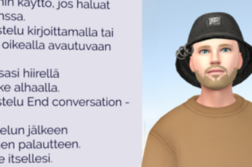Digital pedagogy mentors’ first meeting of the year was held in January 2024. The topic was flexible study mode (24/7) and different flexible implementation styles. In the online workshop, digital pedagogy mentors discussed, for example, why flexibility should be increased, which different flexible implementation styles there are and how they could be implemented with high quality. The flexible study mode and implementations suit well for the needs of the changing world and better enable learning in different life situations and for different learners – also from the perspective of continuous learning.
Flexible implementation styles enable studying in a wide variety of situations
In the workshop, teams of three mentors discussed different flexible implementation ways of studying, and answers were put on the Miro platform. The themes of the discussion were the definition of the various implementations, their strengths as well as the ideas for developing and advancing these implementation types.
24/7 study mode – individual and flexible study path
The 24/7 study mode has been a third way of studying at HAMK for years with daytime studies and studying alongside work. It refers to studying flexibly and at one’s own pace, where students make their personal study plan using different course offerings and can progress individually and at an accelerated pace. This study mode is suitable for students who have a lot of previous experience and are well-prepared for independent studying. In the workshop discussions, the digital pedagogy mentors brought up the following reflections on the 24/7 study mode, for example:
- ”The strength of the 24/7 study mode is that it is one of the attraction factors for HAMK.”
- ”The 24/7 mode makes it possible to study in the most suitable way for the learner.”
- “The best way to develop this mode is to have a clear plan for what and how the modules will be developed, to work as a team and to enable students to move flexibly between different study modes.”
Hybrid and hyflex – learning from anywhere
Hybrid and hyflex learning refers to a flexible combination of contact and distance learning. In it, the student can choose whether to study in person or simultaneously remotely. The hyflex model (hybrid flexible) offers a third path to study: remotely asynchronously. This often means, for example, studying with recordings and other instructions and asynchronous support. In hybrid and hyflex implementations, attention should be paid to the equal learning experience of students and to activating and engaging face-to-face and remote participants equally. Mentors’ thoughts on hybrid and hyflex implementations include:
- ”Hybrid and hyflex implementations have a common schedule for the group in progressing, but learners can choose and combine the participation methods that best suit their individual learning styles.”
- ”It enables students to flexibly choose their own way of participating, even one learning session at a time.”
- ”Developing this kind of implementation requires a lot of time from the teacher for advance planning and, on the other hand, planning teaching sessions. It probably works best when led by a pair or team of teachers.”
Non-stop – flexible time-independent learning
Non-stop implementations refer to a method of implementation that is available to students flexibly and without interruption for a certain period of time. Students can enroll, start studying, study and complete their studies at any time during the running of the implementation. The non-stop implementation mode needs well-planned rhythm of learning. For example, it can include the following four steps: student approval for implementation, integration with the learning platform and studying, progress support and guidance, and assessment.
- “From the student’s point of view, flexibility comes from the fact that the implementation can be started and progressed at any time.”
- ”Non-stop implementation challenges the teachers to consider how to ensure that the students’ learning outcomes are achieved.”
- ”Development requires very good advance planning and Moodle automation expertise.”
MOOC – agile studying for a large number of students
MOOC (Massive Open Online Course) is the name for online courses that are open to everyone and accessible regardless of time and place. The number of participants in a MOOC implementation is unlimited and the implementation must be scalable to a large number of participants. MOOCs are open to everyone and are thought to be of interest to many target groups. MOOCs are credited according to HAMK’s criteria and purposes of use, and thus they include learning assignments. Regarding MOOC implementations, mentors consider the following:
- “MOOCs are an agile way of studying for participants and the implementation mode reaches a large number of students. It can inspire a participant to continue studying the topic further.”
- ”A significant form of learning in society, especially in the future, and can be used to strengthen HAMK’s brand.”
- ”In the development phase, a multidisciplinary working group is needed to support teachers in order to ensure the quality of MOOCs from the viewpoints of accessibility and pedagogical, visual and auditory quality.”
Workshop summary – flexibility benefits all students
Flexible implementation ways and the 24/7 study mode sparked diverse discussion at the end of the workshop. It was jointly agreed that flexible implementation modes and study model enable studying and progress for students in different situations. The development and increase of continuous learning mean more diverse students. Similarly, the life situations of all students change during their studies. It was considered great that flexible ways can offer learning opportunities and take better account of learners’ previous competence, needs and life situation.
Read more
Hybrid leaning – online and face-to-face https://digipedaohjeet.hamk.fi/ohje/hybrid-learning-online-and-face-to-face/?lang=en
Non-stop implementation – unlimited studying and teaching? https://digipedaohjeet.hamk.fi/ohje/nonstop-implementation-unlimited-studying-and-teaching/?lang=en
On the plus side: Functioning cycle is the key to high-quality non-stop implementation https://blog.hamk.fi/digi-hamk/on-the-plus-side-functioning-cycle-is-the-key-to-high-quality-non-stop-implementation/
Purposes and criteria for MOOCs https://digipedaohjeet.hamk.fi/ohje/purposes-and-criteria-for-moocs/?lang=en
Study modes and methods https://www.hamk.fi/en/student-pages/study-modes-and-methods/
On the plus side (in Finnish Plussan puolella) is a series of blog articles covering topics related to digital pedagogy and the work of HAMK’s LeaD Team and digital pedagogy mentors.
Original photo: Adobe Stock



